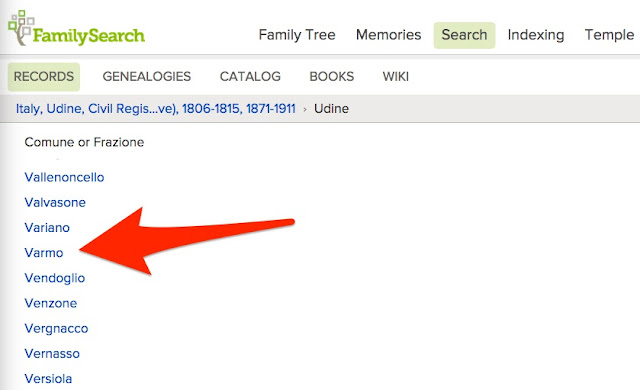This last week or so I was asked to help a patron at the Brigham Young University Family History Library with research into her Italian ancestors. After a short review of the status of her family research, we began by searching the FamilySearch.org Catalog for the place where her ancestors lived. Starting with a general search for "Italy," we looked for "Places within Italy" and found the province where her family lived.
There were a lot of choices, but she already knew that her family came from Udine.
We clicked on the link for Udine and saw the records available for the province.
A further click on the "Places within Italy, Udine" gave us a much longer list. We found the town where her ancestors lived, "Varmo."
One more click took us to the FamilySearch Records for Varmo. There were seven different Civil Registration records for this town in Italy.
We compared the records to the time period when her ancestors lived in this town and began looking at the each of the entries. The first set of records were Civil Registration Records listing births, marriages and death records among others.
Fortunately, the records were digitized and in the Historical Record Collections as indicated by the link in the statement in red. We began our search by looking at the records in the Historical Record Collections.
There were, at the time, 1,262,279 images. These images are not yet indexed as there are no search fields. However the records are organized by location. We clicked on "Browse Records" and moved into the record collection.
We clicked on Udine, to show the records in that location. After scrolling through a long list of place names, we found Varmo.
We then found a chronological list of record sets that we could search. Within minutes we were finding her family members. We continued to find new people to add to her ancestry until she had to leave.
This is remarkable. She had no idea the records for her ancestors were in the FamilySearch.org website. Neither did I for that matter. I had been asked to help her because I could read Italian. But, guess what, I hadn't needed to know one word of Italian to find the records. We found the digitized records by doing a search in the FamilySearch Catalog.
Later, when looking at the new additions to the Historical Record Collections, I found a very interesting fact. The entire Udine Collection had only been added a few days before this patron began her search.
There are several lessons to be learned from this. First, a search of the Historical Record Collections can be started from the FamilySearch Catalog. Second, the list is growing every day and just because you looked yesterday, does not mean the records are not there today. Third, the records can be successfully searched without an Index. Fourth, the records are freely available. Fifth, I didn't need to know Italian to find the record.
What about reading the record once found? Well, that did take a little work in Italian. But, I could have used a Google Translation Search or a dictionary or an Italian Word List online. All of these would have been sufficient to read the records, had I needed them. Which I did not. Another lesson to the missionaries at the BYU Family History Library is the fact that any one of them could have helped this lady. We did not have to wait for someone who could research "Italian" records.














If I am counting correctly, there were 10 steps taken to finally find her family. That seems a little too many to me. How could FamilySearch shorten that process?
ReplyDeleteI didn't really have to go through all those steps. I just do that to illustrate where the records are in the catalog. I also emphasize that there are additional records at each level. You could simply search for Udine.
DeleteI think 10 steps takes very little time or effort if you compare to the two other ways you get the records. Ordering the microfilm takes several weeks to get or flying to Italy! People don't realize how much easier this is, especially in comparison to the alternatives! Thanks for giving such a detailed, easy to understand instructions.
DeleteI think that this is fantastic. I was the one who worked on the mages for Udine and it is great to know that they are useful and usable. 10 steps, if you find your ancestors, is not too many....however stay tuned because the process is being worked on and very soon will be shortened. Also, the FamilySearch wiki has record translations that would be very helpful. Thank you for sharing this experience....I loved it!
ReplyDeleteI went through the steps to find Locatello, Bergamo, Lombardia, where my own family comes from and it worked. But you can also search through the site "antenati" which is the Italian government site. It even welcomes you in English. It is very well done and very responsive.
ReplyDeleteThat comment about the fact that the collection had just been put up first gave me chills and then tears.
ReplyDelete